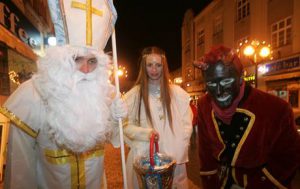Mikulaš and Santa Claus
By Erin Naillon
Mikulaš and Santa Claus
 The real Saint Nicholas was quite different from modern depictions of him. Rather than a jolly, rotund elderly man with a herd of reindeer, Saint Nicholas was a Greek from the Mediterranean port of Patara. His parents were wealthy Christians, and Nicholas was their only child. His uncle, also named Nicholas, raised the young boy when both his parents died in an epidemic; in adulthood, Nicholas became Bishop of Myra.
The real Saint Nicholas was quite different from modern depictions of him. Rather than a jolly, rotund elderly man with a herd of reindeer, Saint Nicholas was a Greek from the Mediterranean port of Patara. His parents were wealthy Christians, and Nicholas was their only child. His uncle, also named Nicholas, raised the young boy when both his parents died in an epidemic; in adulthood, Nicholas became Bishop of Myra.
Miracles
Several miracles have been attributed to Saint Nicholas, including the ability to restore to life the bodies of three murder victims and to calm a stormy sea with his prayers. One popular story is that the saint heard of a poor man who was unable to provide dowries for his three daughters. Nicholas went to the house by night and threw three purses filled with gold through the windows (or, in one variant, down the chimney and into a stocking). The daughters were thus able to marry.
Death and Pilgrimage
Saint Nicholas died on December 6, A.D. 343. Already very famous, his burial site was the subject of much interest in the following centuries. In 1087, sailors from Bari snatched his remains from his grave and transported them back to Italy, where they were reburied. While Nicholas’ remains were in Myra, they produced a liquid smelling of rose water. After the move to Bari, this miracle continued; to this day, one can buy a bottle of this liquid at a shop near his tomb.
Santa Claus
The name “Santa Claus” comes from the Dutch, Sinterklaas, derived from the Greek for “Saint Nicholas”. Nicholas was fond of giving gifts anonymously, and in almost two thousand years, Santa has come into being, a grandfatherly figure delivering toys to children on Christmas.
Mikulaš
In the Czech Republic, the custom of Mikulaš provides good fun for children and adults on December 5, the eve of the anniversary of the saint’s death. On this day, three figures visit children throughout the country. One is dressed as Saint Nicholas; one is dressed as an angel; the third is dressed as a devil. These three imposing figures ask the children if they have been good all year. If not, the devil gives them coal (supposedly; in reality, this does not happen). The children receive small, pre-Christmas gifts from the trio. In past years, at least one of the figures was usually played by a child’s father. These days, parents can rent a Mikulaš trio, so that the children are unable to see through the disguise and recognize a familiar figure.



